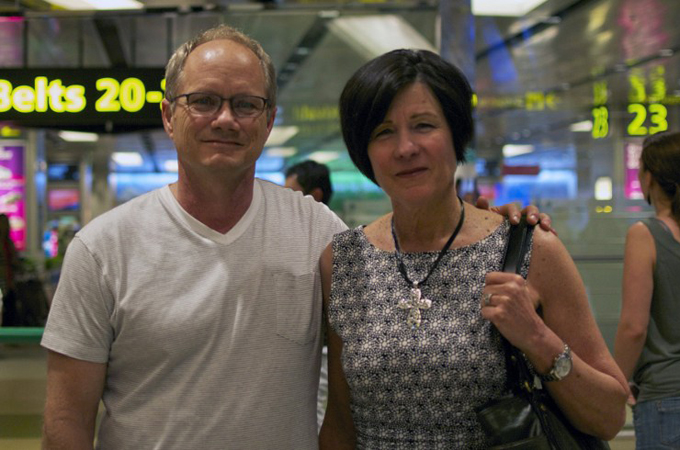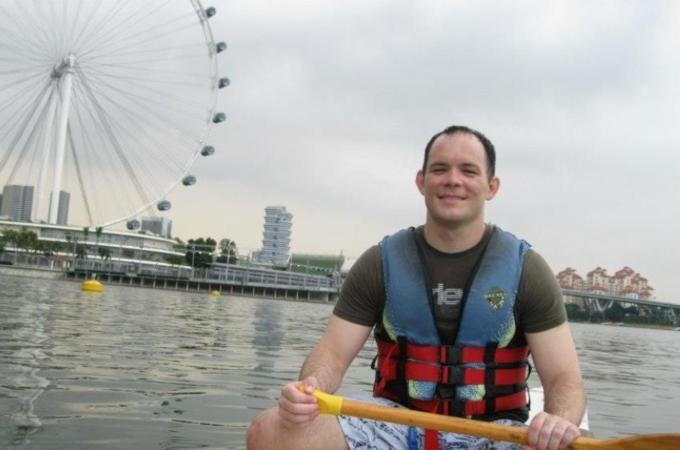American’s death in Singapore ruled suicide
Coroner says scientist hanged himself but questions about China and high-tech secrets remain.

Singapore – Authorities in Singapore have ruled that American electronics engineer Shane Todd, whose hanging death in June 2012 touched off accusations of espionage and murder, was a victim of suicide.
State coroner Chay Yuen Fatt on Monday told a packed courtroom in Singapore’s Subordinate Courts building that there was no foul play, and Todd died by asphyxia caused by hanging.
The finding was immediately rejected by family members who say Todd died an American hero, trying to stop the secret transfer of highly sensitive US military technology from his Singapore research agency employer to a Chinese telecommunications giant suspected by some countries of manufacturing devices that can be used for spying.
“We are disappointed, but not surprised, by the coroner’s verdict of suicide,” the Todd family said in a statement.
Singapore will want to demonstrate that it is not a pawn in this rivalry between US and China.
The coroner’s inquiry focused on the cause of death. Larger questions raised by the case remain: did a clandestine plot actually exist to transfer US export-controlled technology to the Chinese, and could its possible revelation have motivated a suicide or a murder? A separate and highly delicate investigation into whether Todd or his employer actually possessed technological information that may have compromised US national security is planned, but not yet under way.
Last March, trying to calm angry US officials threatening to cut off Defense Department funding to a Singaporean research agency, Singapore’s Foreign Affairs and Law Minister K Shanmugam invited the US to participate in a full investigation into whether US national security was put at risk. But the two countries have to yet agree on the terms. Given its slow start and worries about diplomatic toe-stepping and turf issues, analysts are not sure if the investigation will be conclusive.
“Singapore will want to demonstrate that it is not a pawn in this rivalry between US and China,” said Eugene Tan, an associate professor of law at Singapore Management University.
While the US expects the investigation to be led by its Department of Commerce’s Bureau of Industry and Security, Singapore will insist that the US respect its sovereignty in the matter, Tan said.
Disputed facts
The case has all the makings of a spy thriller with international political and diplomatic ramifications. Its players include one of America’s most important Asian allies, Singapore, and its greatest regional rival, China; and a bright young American researcher who complained to his family that his work with an unnamed Chinese company had put his life in danger.
Among the facts in the case that are not in dispute: the 31-year-old Todd finished the last day of his 18-month job on June 22, 2012, and his body was found hanging from a bathroom door in his Chinatown apartment on June 24.
His girlfriend, Shirley Sarmiento, a Filipino nurse working in Singapore, said she had been expecting to hear from him but did not, so she went to his apartment and discovered his body. At the time of his death, he had been packing his belongings in preparation for his move back to the United States, where a new job and a new life awaited.
 |
| Rick and Mary Todd, parents of US scientist Shane Todd [AFP] |
From there on, the facts are highly disputed.
Singapore police considered the case an apparent suicide, with no signs of a forced entry. Suicide notes were found; the case seemed clear-cut.
Rushing to Singapore from their home in Montana following news of their son’s death, Mary and Rick Todd began to cull evidence from his apartment that convinced them their son was the victim of foul play. They were already apprehensive: Todd had told them via regular Skype conversations that he was beginning to worry that his work on military-grade technology with a Chinese firm could endanger US national security – and his own personal security.
The Todds embarked on a high-profile campaign that would reach top levels of government and strain the normally cordial relations between Singapore and Washington.
Family members were surprised the police had not treated the apartment as a crime scene, and that its layout did not resemble the description they had been given by police. Suicide notes did not appear to be written by Shane, they said. They hired a US pathologist who detected evidence in mortuary photographs that Todd put up a struggle before his death.
Sensitive technology
While still at the apartment, the Todds said they found an external hard drive that had been missed by investigators, and hired a private forensic investigator to determine its contents. The investigator found it contained plans for a sensitive project between Shane Todd’s employer, the Institute for Micro Electronics (IME), and Chinese telecom giant Huawei Technologies. IME is a unit of Singapore’s Agency for Science, Technology and Research; Huawei is the world’s second-largest telecom-equipment vendor, and has been deemed a potential security risk by governments, including the US and Australia over fears that Beijing could use the firm for economic or military espionage.
The plan found on the hard drive, according to the investigator, was to co-develop an amplifier device powered by gallium nitride (GaN), a material that can withstand high temperatures and can be used for advanced radar and satellite communications. The material is under development in the US but restricted for export because of the potential military applications. Both the IME and Huawei later testified that they did not go beyond initial discussions into a possible project involving GaN.
The parents kind of made it difficult for themselves by walking out half way. They didn't stay through the proceedings, and that gives a sense that their reaction has been emotional.
A February 15, 2013 investigative report in the Financial Times headlined “Death in Singapore” detailed the Todds’ allegations, as well as Shane Todd’s work in Singapore. The attendant publicity, and the implication of a possible transfer of sensitive technology to the Chinese military through Huawei in violation of US export law, caused a political uproar. US Senator Max Baucus of Montana, chairman of the Senate Finance Committee, along with Montana Senator Jon Tester, in March called for contracts, loans, and research funds worth some US$500,000 from going to the IME until the FBI was given full access to evidence in Todd’s death investigation. The proposal has yet to be enacted.
Baucus complained that the Singaporean police and government “have been less than forthcoming,” and shared his concerns with the White House.
Singapore publicly expressed its disappointment at the congressional threat and disavowed any connection to the IME’s projects and possible technology transfers to China.
“The issue of applying ‘pressure’ should not arise between countries, which have had a long, open and cooperative relationship with each other based on mutual respect,” Singapore’s Foreign Ministry said in a statement. “We are deeply disappointed by the senators’ actions and statements.”
Full cooperation
Singapore’s Foreign Minister Shanmugam met in Washington with Baucus, Secretary of State John Kerry, and Attorney General Eric Holder. He pledged full cooperation with the US on Todd’s death and the circumstances surrounding it.
A coroner’s inquiry into the cause of death was conducted over two weeks from May 13-27, 2013, producing additional information. Singaporean investigators presented evidence that a psychiatrist had prescribed anti-depressants to Todd, who had a history of depression, and that Todd’s laptop showed a history of visits to suicide-related websites, including a search on how to tie a hangman’s noose.
Two medical examiners from the US corroborated a finding by the Singapore government’s forensic pathologist that there was no evidence that Todd had put up a struggle before his death, and determined marks on Todd’s hands identified by the Todd family’s pathologist were not bruises from a fight, but were actually a classic example of post-mortem symptoms in hanging cases. The original pathologist hired by the Todds reversed his earlier testimony that Shane Todd had been garroted after Singapore authorities showed no evidence of broken blood vessels in the neck that would have been signaled strangulation by a wire or cord.
Other testimony revealed the hard drive in Todd’s apartment had been checked for evidence by Singapore police, and it was handed over to the family in the presence of US Embassy officials – contradicting the Todd’s original claim that they found it themselves.
 |
| Shane Todd while in Singapore, months before his death |
The Todds stormed out of the inquiry on May 21, calling the proceedings “one-sided” and saying they had “lost faith” in a fair trial. “We have decided that our presence in Singapore will have no bearing on the outcome,” the family said in the statement. “The Todd family will now turn to the court of public opinion.”
But observers say the family’s abrupt departure signaled a weakness in their case.
“The parents kind of made it difficult for themselves by walking out half way,” said PN Balji, a veteran Singaporean political observer. “They didn’t stay through the proceedings, and that gives a sense that their reaction has been emotional.”
Following the release of the suicide finding on Monday, the Todd family unveiled a new website signaling they will continue to press their case, as well as a blow-by-blow rebuttal of the coroner’s finding titled, “Getting Away With Murder in Singapore.”